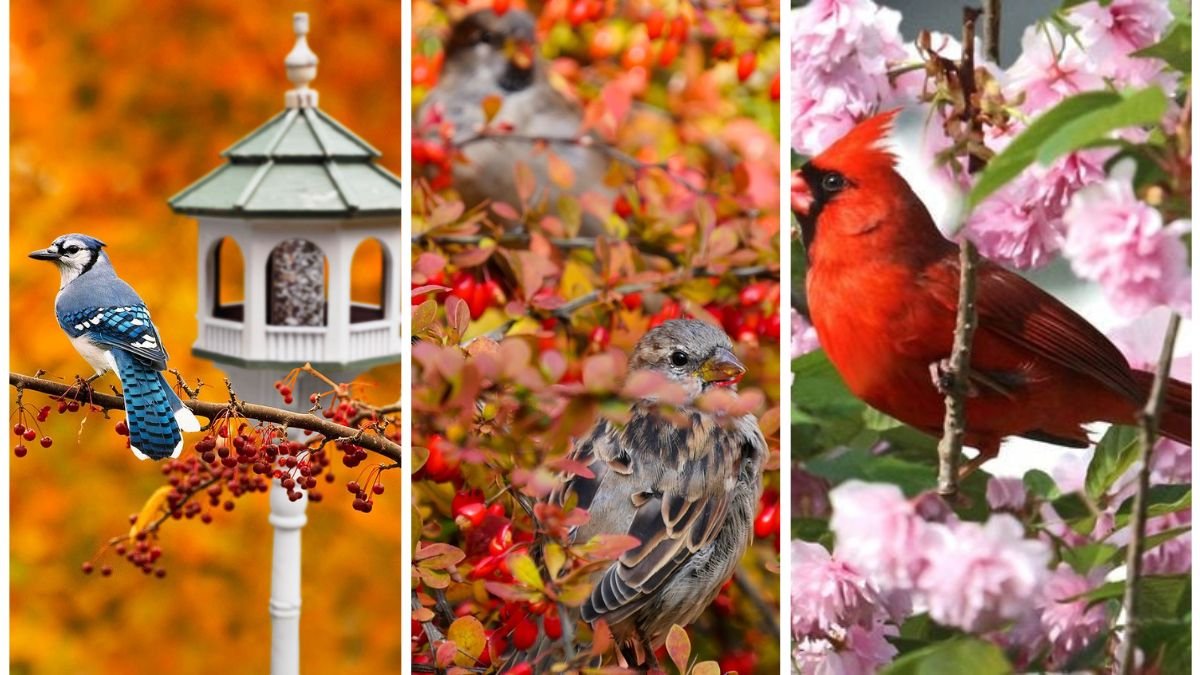In an increasingly urbanized world, creating a safe haven for birds in your own yard is not only good for wildlife—it’s deeply rewarding for homeowners. Birds add life, song, movement, and natural pest control to your landscape. But if you want to turn your backyard into a true avian paradise, planting the right trees is essential.
Trees provide birds with food, shelter, nesting sites, and safety from predators. Some trees are better than others at attracting a variety of bird species, depending on their fruit, seeds, flowers, or structure.
In this article, we’ll highlight five exceptional trees that attract birds to your yard—with detailed information on why they work, which species they attract, and how to care for them.
1. Serviceberry (Amelanchier spp.)
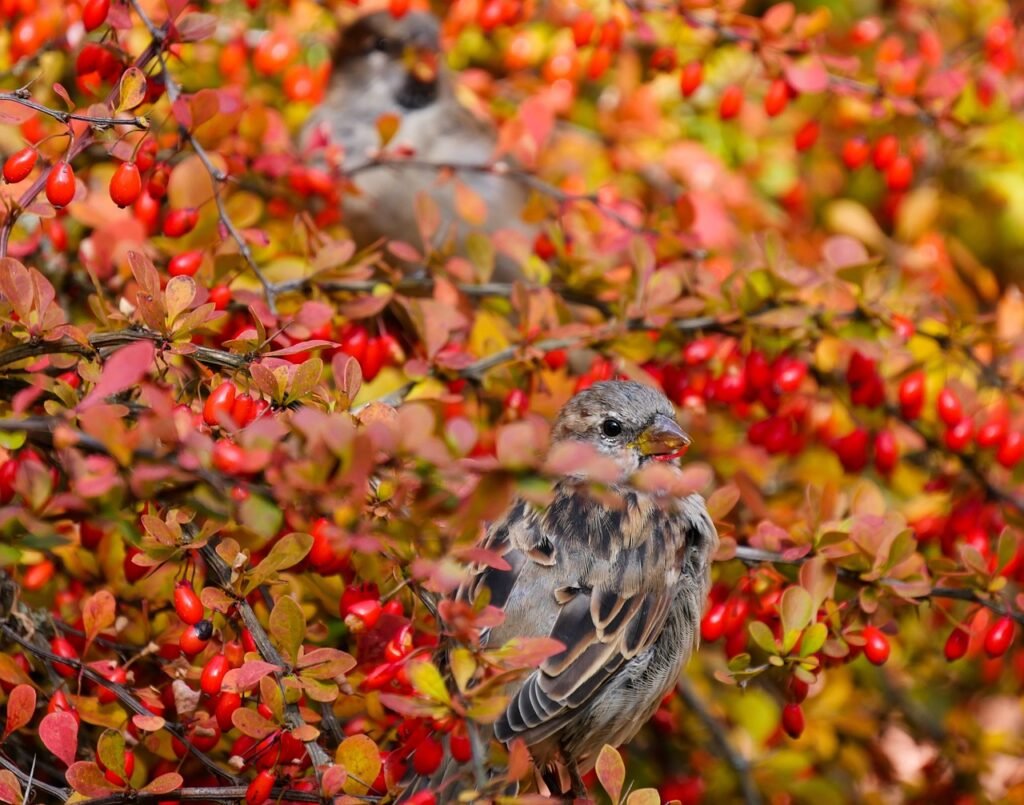
Also known as Juneberry, Shadbush, or Saskatoon
Why Birds Love It:
Serviceberry trees produce sweet, red-to-purple berries in early summer, which are a magnet for dozens of bird species. The small size and open branching also make it easy for birds to perch, nest, and forage.
Bird Species Attracted:
- American Robins
- Cedar Waxwings
- Northern Mockingbirds
- Cardinals
- Thrushes
- Blue Jays
Additional Benefits:
- Stunning white blossoms in early spring
- Brilliant orange to red fall foliage
- Edible berries for humans, too!
Growing Info:
- Height: 15–25 feet (depending on variety)
- Light: Full sun to partial shade
- Soil: Moist, well-drained
- Zones: 4–9
Maintenance Tips:
- Prune lightly after flowering to shape
- Watch for cedar-apple rust (especially in humid areas)
- Mulch around base to retain moisture
2. Eastern Red Cedar (Juniperus virginiana)
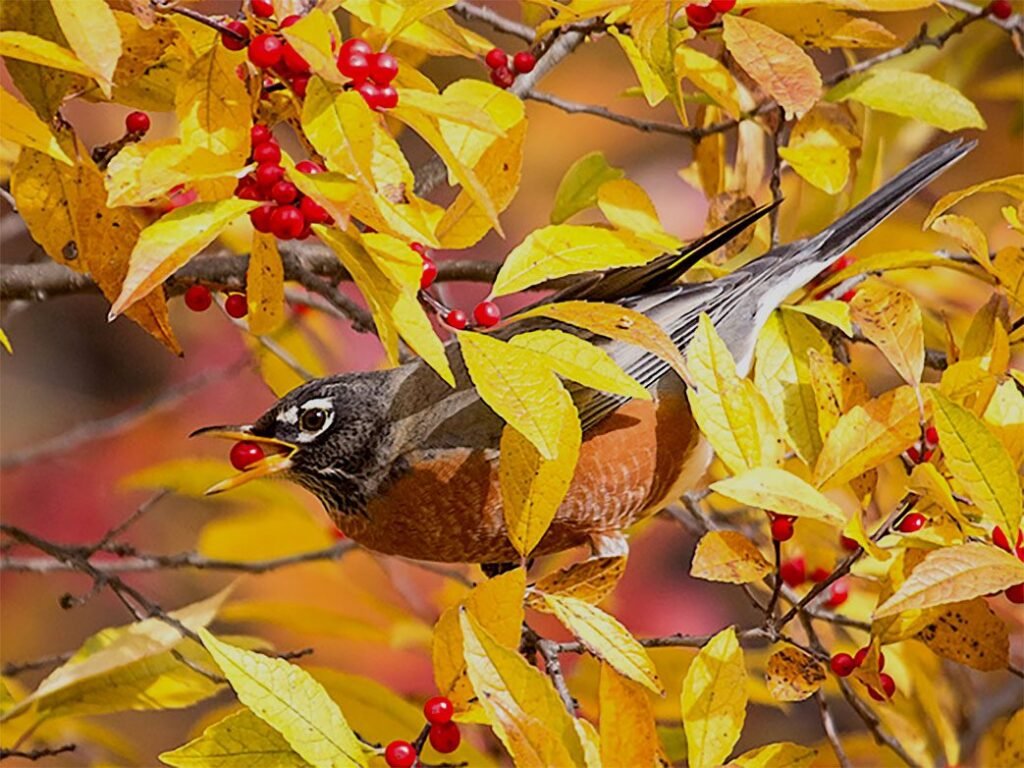
A native evergreen that birds adore
Why Birds Love It:
Eastern Red Cedar produces blueish, berry-like cones that are rich in sugars and oils—perfect for birds in fall and winter. As an evergreen, it provides year-round cover and nesting protection, especially in cold weather.
Bird Species Attracted:
- Cedar Waxwings
- Eastern Bluebirds
- American Robins
- Northern Flickers
- Mourning Doves
- Mockingbirds
Additional Benefits:
- Shelter from snow and predators in winter
- Host plant for several native moths and butterflies
- Durable, drought-tolerant, and long-lived
Growing Info:
- Height: 30–50 feet
- Light: Full sun
- Soil: Adaptable, even poor or dry soil
- Zones: 2–9
Maintenance Tips:
- Plant both male and female trees for fruit production
- Minimal pruning needed
- Tolerates deer and wind well
3. Flowering Dogwood (Cornus florida)
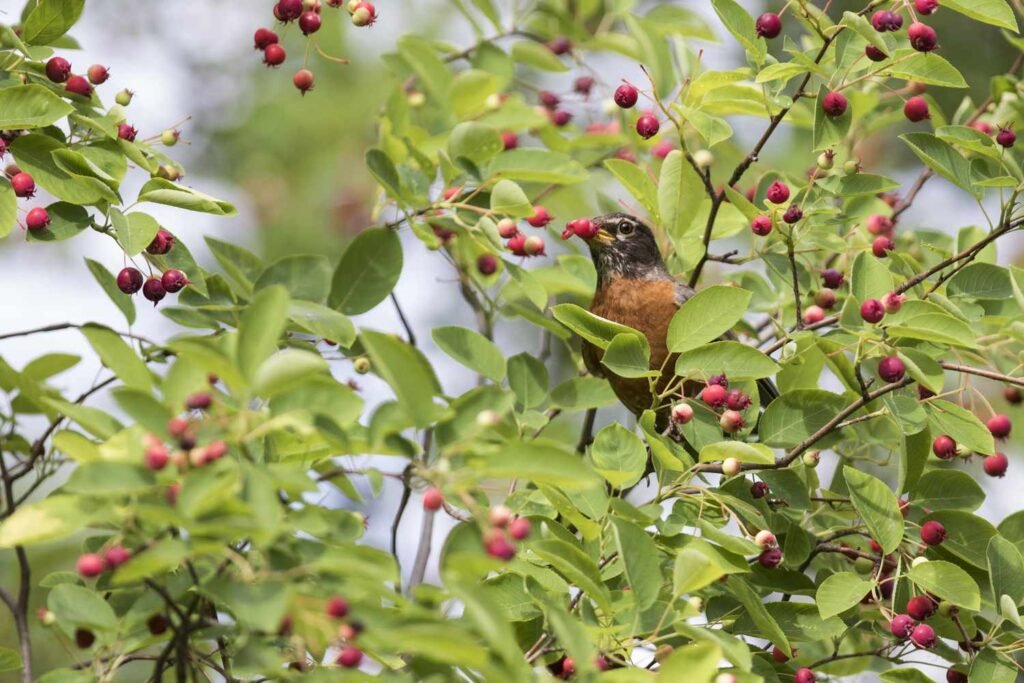
Beauty and bird appeal rolled into one
Why Birds Love It:
Dogwood berries ripen in late summer and fall, offering a valuable food source. The tree’s horizontal branching and dense canopy provide great nesting sites. Plus, the red fruits contrast against fall foliage, making them easy for birds to find.
Bird Species Attracted:
- Cardinals
- Bluebirds
- Warblers
- Grosbeaks
- Catbirds
Additional Benefits:
- Iconic white or pink spring flowers
- Vibrant red fall color
- Compact size ideal for residential landscapes
Growing Info:
- Height: 15–30 feet
- Light: Part shade to full sun (shade preferred in hotter regions)
- Soil: Moist, well-drained, acidic
- Zones: 5–9
Maintenance Tips:
- Avoid planting in areas prone to anthracnose
- Water during droughts
- Add compost to enrich soil and retain moisture
4. Oak Trees (Quercus spp.)
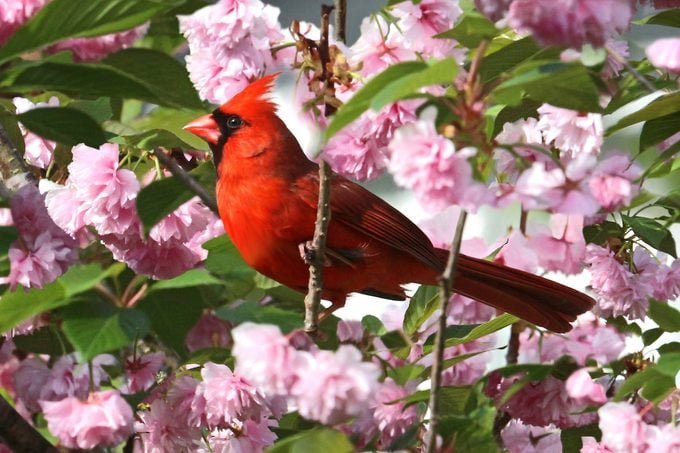
The single most valuable tree genus for birds and wildlife
Why Birds Love It:
Oaks don’t just provide acorns—they support a vast network of life. According to renowned entomologist Dr. Doug Tallamy, a single white oak can host over 500 species of caterpillars, which are critical food sources for baby birds.
Bird Species Attracted:
- Woodpeckers
- Jays
- Chickadees
- Warblers
- Nuthatches
- Turkeys
- Hawks (nesting in mature oaks)
Additional Benefits:
- Long lifespan (centuries in some cases)
- Shade provider and carbon sink
- Strong branches ideal for nesting raptors and songbirds alike
Growing Info:
- Height: 50–100+ feet (varies by species)
- Light: Full sun
- Soil: Deep, fertile, well-drained
- Zones: 3–9
Maintenance Tips:
- Choose a native oak species (e.g., White Oak, Northern Red Oak)
- Allow space—these are large trees
- Minimal pruning needed; focus on structural training in early years
5. Crabapple (Malus spp.)
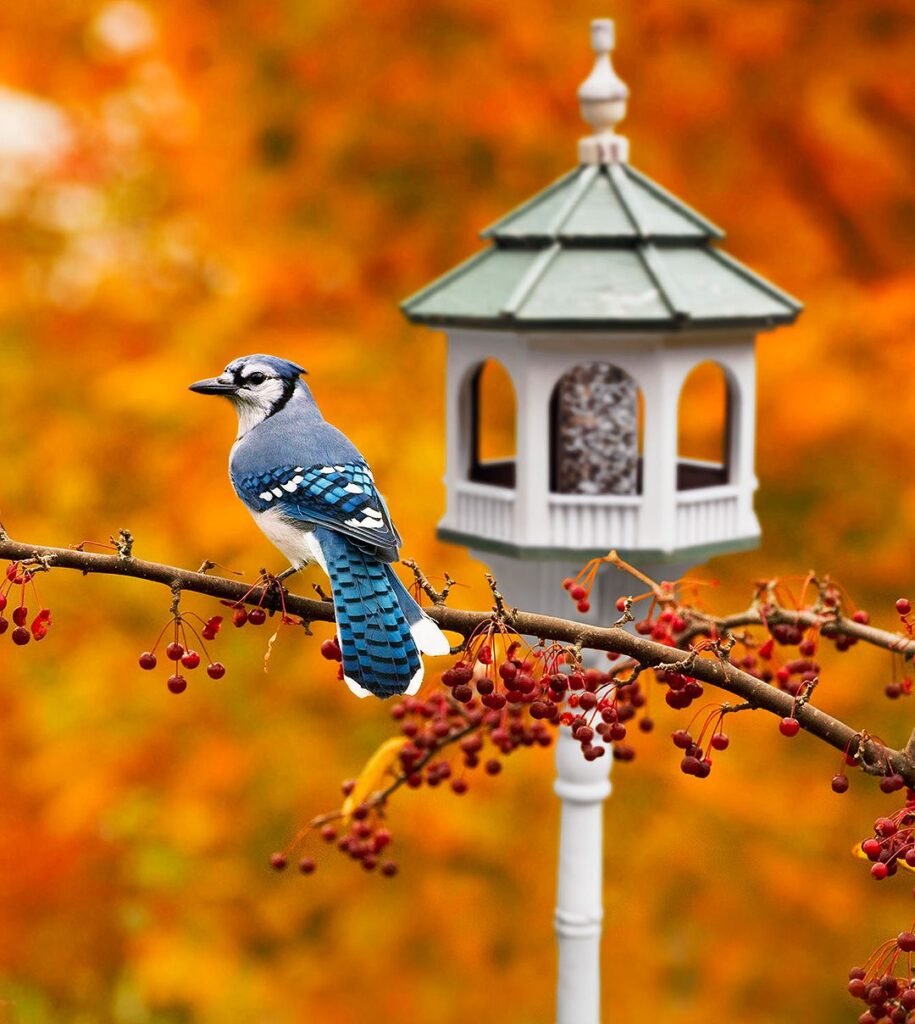
Ornamental charm with a feast for birds
Why Birds Love It:
Crabapples provide small, persistent fruits that remain on the tree through fall and even into winter. This extended availability makes them vital food sources when insects and berries are scarce.
Bird Species Attracted:
- Waxwings
- Finches
- Thrushes
- Robins
- Sparrows
- Northern Flickers
Additional Benefits:
- Spectacular spring blossoms
- Compact size—perfect for urban gardens
- Pollinator magnet (bees, butterflies)
Growing Info:
- Height: 10–25 feet
- Light: Full sun
- Soil: Well-drained; adaptable
- Zones: 4–8
Maintenance Tips:
- Choose disease-resistant varieties like ‘Prairifire’ or ‘Adams’
- Prune in late winter to maintain form
- Remove fallen fruit to prevent pests
Bonus Tips: Enhancing Your Yard for Birds
Planting bird-friendly trees is just the beginning. Here’s how to transform your yard into a true bird sanctuary:
1. Diversify Your Plantings
Include shrubs, perennials, and groundcovers that offer nectar, berries, or shelter. Native plants are best.
2. Add a Water Source
Birdbaths, shallow ponds, or fountains help birds drink and bathe. Moving water (like a bubbler) attracts even more species.
3. Skip the Chemicals
Pesticides kill the very insects birds rely on for protein—especially for feeding their young.
4. Leave Some Natural Debris
Dead trees (snags), leaf litter, and brush piles are essential for foraging and nesting for many species.
5. Install Nesting Boxes
While many birds nest in trees, others like wrens, chickadees, and bluebirds benefit from well-placed boxes.
Why Native Trees Matter
Choosing native tree species whenever possible is key. Native trees have evolved alongside local bird populations, providing the precise food and habitat they need. Non-native trees may not support insects or may fruit at the wrong times.
Organizations like the National Audubon Society and Native Plant Finder (by ZIP code) can help you choose the right natives for your region.
Final Thoughts
Creating a bird-friendly yard isn’t just about tossing out a feeder—it’s about planting for the future. Trees are the foundation of any healthy habitat, and the right selections can provide beauty, privacy, shade, and a bustling ecosystem of feathered life.
To recap, the top 5 trees that attract birds to your yard are:
- Serviceberry – Early berries, multi-season interest
- Eastern Red Cedar – Winter shelter and food
- Flowering Dogwood – Gorgeous blooms and fall fruit
- Oak Trees – Unmatched wildlife value
- Crabapple – Persistent fruit for winter feeding
By planting even one or two of these species, you’ll invite a symphony of songbirds, an explosion of life, and the quiet satisfaction of knowing your landscape is doing more than just looking good—it’s giving back.
